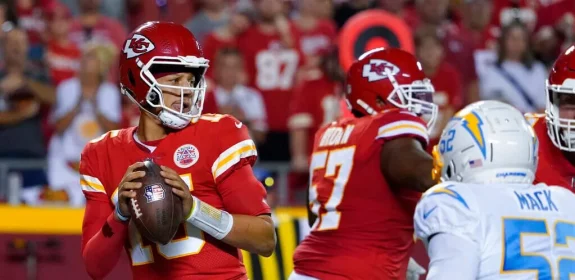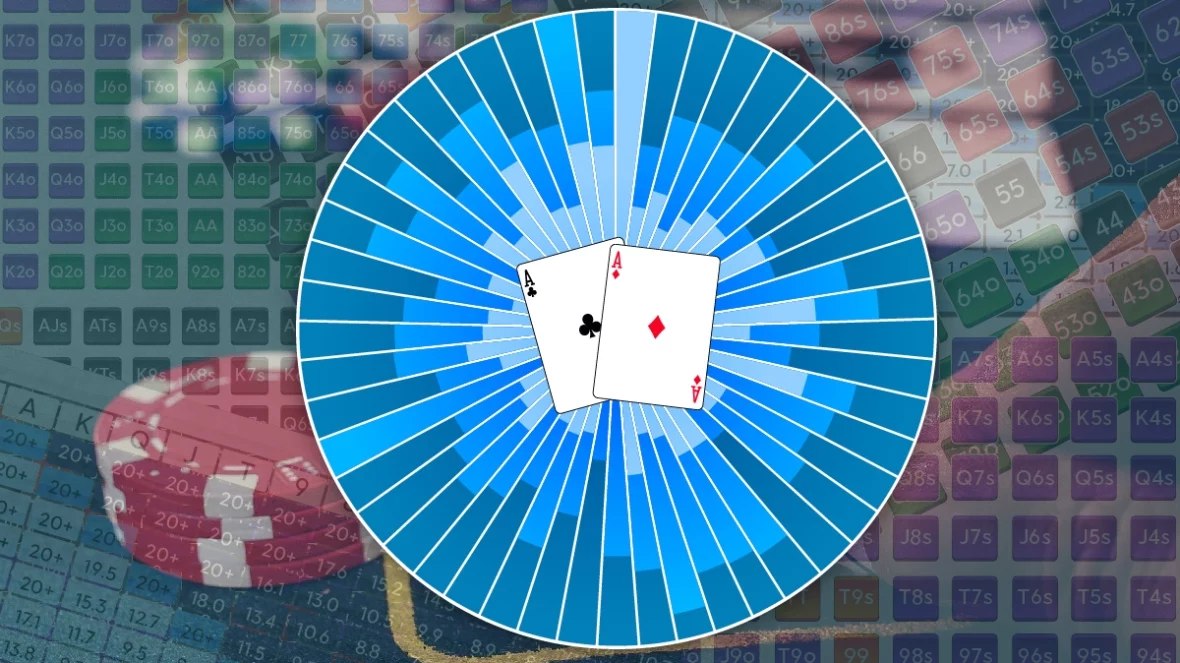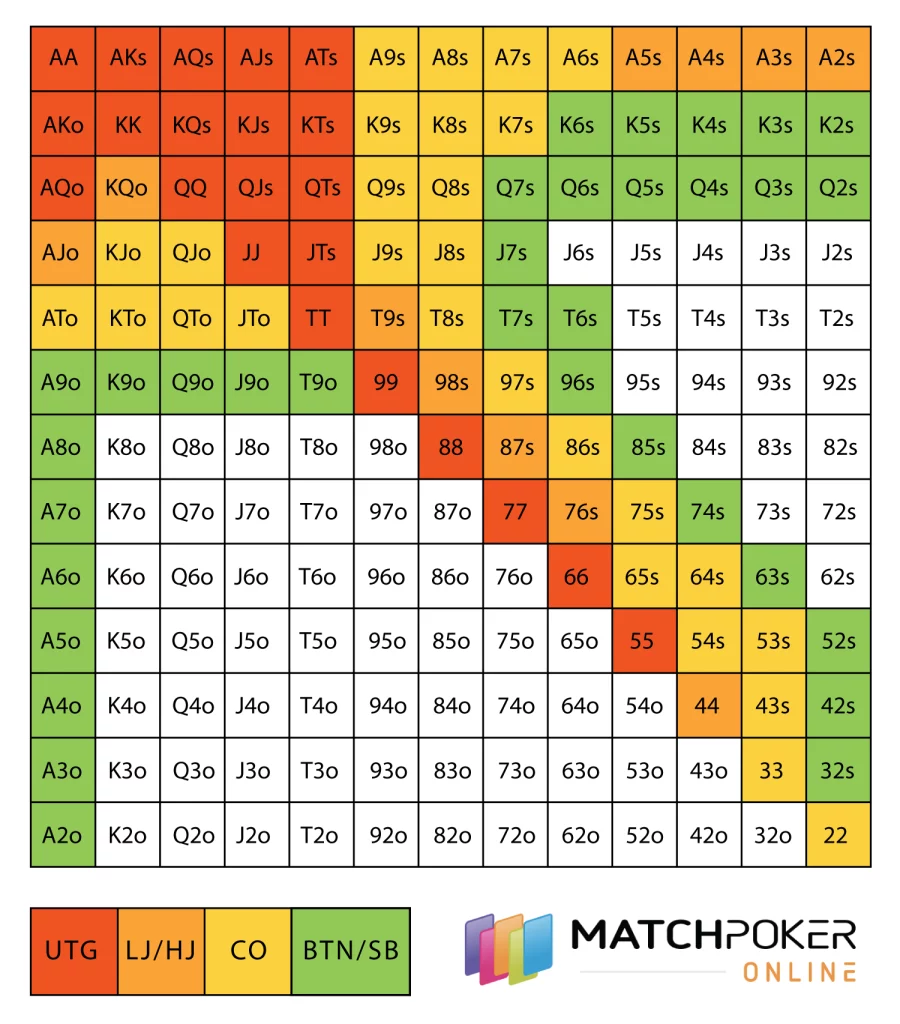
NFL Playoff Predictions – Superbowl 57 Picks
FL Regular season is over, and once again we head to the very exiting playoff…

In the old days, people tried to figure out what their opponents were holding by observing how they played hands: “When she bet on the flop, I knew she had AA,” or “When he raised preflop, I thought he had AK.” Hand ranges are not what they used to be because when you raise or bet on the flop, you are not using just one combination of hands; you are using the full range.
For example, you are UTG and raise 3bb in a cash game. You would play AA, KK, QQ, JJ, TT, 99, 88, 77, AKo, AQo, AKs, AQs, AJs, ATs, KQs, QJs, and JTs (plus or minus a few hands depending on your playing style). In a cash game, you would usually use AA, KK, QQ, JJ, TT, 99, 88, 77, AKo, AQo, AKs, AQs, AJs, ATs, KQs, QJs, and JTs (plus or minus a few hands depending on your playing style). You can track this easily using a range chart, which denotes each hand’s range.
A poker range chart illustrates the various possible hands in Texas Hold’em. They can be arranged on a 13×13 board in three configurations: suited hands in the top right, offsuit hands in the bottom left, and pocket pairs running from top left to bottom right. You can use a poker range chart to get a better idea of your opponent’s hand selection by highlighting them.

How do we use poker ranges in-game? To handread, we estimate the ranges our opponents start with and compare them to their betting patterns to see what hands from our range they are representing. We do this by estimating the ranges our opponents start with and comparing them to their betting patterns to see what hands from our range they are playing. For example, if our opponent 3bets preflop, bets the flop, and turn on an Ad9c6s4s2d board, they are representing hands like AA, AK, AQ, and AJ for value and could have hands like KQ, QJ, and 87 as bluffs.
Keeping your opponent’s range constant throughout the hand is vital. By assuming that a player can have a specific hand in their range on the turn when they actually discounted it prior to the flop or preflop, we often fall into the trap of suddenly assuming they can have it. Let’s take a look at an example:
You’re playing a nine-handed table and your opponent raises with 3d4d in the big blind. In this scenario, you think your opponent is a solid player and range 77+, AQo+, AJs+, JTs+. The flop comes 3s4s5d. You check, your opponent bets, you raise, and your opponent shoves. You shouldn’t be worried that your opponent has a straight with 76 or A2, a better two pair with 53 or 54, or a set with 33, 44, or 55, since those hands were not in our opponent’s estimated preflop range.
When attempting to identify your opponent’s range, begin by working with their preflop range estimation; as their actions provide you with more information, you can remove more and more cards until you have a better idea of their hand composition.
The most challenging aspect of playing poker ranges is estimating what ranges your opponents are playing. We will never truly know how our opponents think, but we can use the information to come as close as possible to guessing what hands they will play. Here are some things to keep in mind when constructing a range for your opponent:
Perhaps this information is relevant for the page, since it discusses live play rather than online play. To be discussed.
At the poker table, everyone is equal, but a player’s appearance, age, and demeanor can give you an idea of how they’ll behave. Everyone is at the same disadvantage, but older players are typically less tight because of the preconceived notion that they are risk-averse.
Wearing what a player is comfortable in can give you an idea of how he or she plays as well. For example, if your opponent is dressed casually in jeans and a hoodie like they just rolled out of bed, they’re probably a frequent gambler—casinos aren’t the place for people who dress up. However, if your opponent is wearing a cocktail dress or a business suit, they’re probably a novice at gambling.
Regardless of who it is or what they look like, you are trying to find out how loose or tight this player will play in comparison to the norm.
Once you’ve figured out what sort of challenge you are facing, look at their position. UTG, LJ, or BTN? A player’s position will drastically change the range composition (as long as they’re a competent player) if they’re playing UTG. If they’re raising from one of the early positions, their range will most likely be more compact; if they’re raising from one of the late positions, their range will most likely be bigger.
When examining your opponent’s preflop range from their position, you must take into account all of the inferences you’ve drawn. This means you must combine your information in order to form an overall picture of your opponent. For example, if you observe that your opponent is an 85-year-old who looks like he’s about to fall asleep, it’s likely that even on the button, his range will be limited, so you should adjust your ranges accordingly.
Your opponent’s actions during a hand, both pre- and post-flop, should influence the range you put him or her on. Prior to the flop, did your opponent three-bet or call? What about on the flop? Did they limp, raise, or call a raise? Your opponent will respond to your hand in a different way depending on what he or she does. For example, most players will not call a raise with AA, instead, they will three-bet. By thinking about your opponent’s range in this manner, you may be able to eliminate certain hands.
If your opponent raises from the big blind when you raise from the button with Ah8h, then they’re likely to have a range with different hands. The same principle applies postflop; your opponent’s actions will alter their hands. Let’s take a look at a scenario where you raise from the button with Ah8h and your opponent calls. The flop comes 8c6s2h, your opponent checks, you bet the size of your pot, and your opponent calls. A Qs comes on the turn. Should you be worried about it? First, let’s examine your opponent’s actions. In preflop, they would call a Qx hand, but they also called a pot-sized bet on an 8c6s2h turn. Because their range is more likely to comprise of pairs and straight draws, the Qs is actually a safe card for us despite it being an overcard.
Make sure to keep a close eye on your opponents to see if they are doing anything unexpected based on the profile you’ve created for them. If you think the player is tight, but you see a showdown where they raised UTG with T5s–pay attention. Your first thought was most likely incorrect, so you need to adjust it.
Players should always gather information while at the poker table and use it to better understand their opponents’ tendencies, rather than assuming what they do.
Since you can’t get a full picture of your opponent’s range by considering these four points, you can get a decent idea of the hands by considering them.
To learn about how to construct your own preflop ranges, check these out:
If you’re going all-in, low pocket pairs lose a lot of value as your stack gets smaller. They’re excellent for making a set and winning a big pot by cracking an overpair; on the other hand, they’re very difficult to play when you don’t make a set, and you’ll either need to fold or call down, hoping that your opponent is bluffing.
Players will always play suited hands because they can make a flush, and well, a flush is a strong hand. Next, they’ll realise that a suited hand provides you with 2-3% more equity, so they play the same number of offsuit hands. In the end, suit cards provide you with more equity, allowing you to barrel and win the pot without a showdown, even though the actual increase is small.
Make sure that there are more suited hands than offsuit hands when building your range.
A low-suited connector hand is extremely popular for playing because you can make some incredible hands with them and also beat an opponent’s overpair. However, from early positions, these hands lose a lot of their worth because there is a greater chance that when you make a large hand like a straight or a flush, you will be up against someone with the higher end of it. Furthermore, you do not make those strong hands very often, so you will either have to bluff your way out of trouble or check-fold most of the time.
Many new players believe that they can make plays from early position that cover a wide range of hands. Although this is a fixable error, many players still think too highly of the number of hands they can play from early position. Players frequently make bluffs like ATo and QJo from UTG, thinking they are valuable hands; in reality, these hands are poor raises. Therefore, when playing from early position, err on the side of caution—if you aren’t sure whether or not you should raise a hand, you shouldn’t.